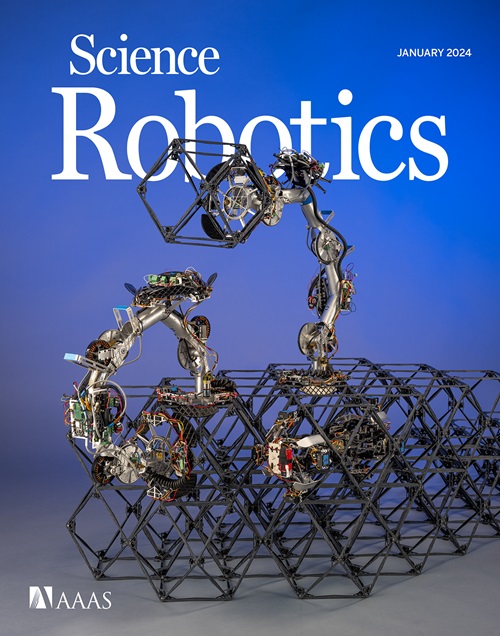Hexagonal electrohydraulic modules for rapidly reconfigurable high-speed robots
IF 26.1
1区 计算机科学
Q1 ROBOTICS
引用次数: 0
Abstract
Robots made from reconfigurable modular units feature versatility, cost efficiency, and improved sustainability compared with fixed designs. Reconfigurable modules driven by soft actuators provide adaptable actuation, safe interaction, and wide design freedom, but existing soft modules would benefit from high-speed and high-strain actuation, as well as driving methods well-suited to untethered operation. Here, we introduce a class of electrically actuated robotic modules that provide high-speed (a peak contractile strain rate of 4618% per second, 15.8-hertz bandwidth, and a peak specific power of 122 watts per kilogram), high-strain (49% contraction) actuation and that use magnets for reversible mechanical and electrical connections between neighboring modules, thereby serving as building blocks for rapidly reconfigurable and highly agile robotic systems. The actuation performance of each hexagonal electrohydraulic (HEXEL) module is enabled by a synergistic combination of soft and rigid components; a hexagonal exoskeleton of rigid plates amplifies the motion produced by soft electrohydraulic actuators and provides a mechanical structure and connection platform for reconfigurable robots composed of many modules. We characterize the actuation performance of individual HEXEL modules, present a model that captures their quasi-static force-stroke behavior, and demonstrate both a high-jumping and a fast pipe-crawling robot. Using embedded magnetic connections, we arranged multiple modules into reconfigurable robots with diverse functionality, including a high-stroke muscle, a multimodal active array, a table-top active platform, and a fast-rolling robot. We further leveraged the magnetic connections for hosting untethered, snap-on driving electronics, together highlighting the promise of HEXEL modules for creating rapidly reconfigurable high-speed robots.
用于快速可重构高速机器人的六边形电动液压模块
与固定设计相比,由可重构模块单元制成的机器人具有多功能性、成本效益和更高的可持续性。由软致动器驱动的可重构模块可提供适应性强的致动、安全的交互和广泛的设计自由度,但现有的软模块将受益于高速和高应变致动,以及非常适合无系绳操作的驱动方法。在这里,我们介绍了一类电驱动机器人模块,这些模块可提供高速(峰值收缩应变率为每秒 4618%,带宽为 15.8 赫兹,峰值比功率为每公斤 122 瓦)、高应变(收缩率为 49%)驱动,并使用磁铁实现相邻模块之间的可逆机械和电气连接,从而成为可快速重新配置和高度灵活的机器人系统的构建模块。每个六边形电液(HEXEL)模块的驱动性能都是通过软部件和硬部件的协同组合实现的;由刚性板组成的六边形外骨骼放大了软电液驱动器产生的运动,并为由多个模块组成的可重构机器人提供了机械结构和连接平台。我们描述了单个 HEXEL 模块的致动性能,提出了一个能够捕捉其准静态力-行程行为的模型,并演示了高跳和快速管道爬行机器人。利用嵌入式磁连接,我们将多个模块排列成具有不同功能的可重构机器人,包括高冲程肌肉、多模态主动阵列、桌面主动平台和快速滚动机器人。我们还进一步利用磁性连接来承载不受约束的卡入式驱动电子元件,从而凸显了 HEXEL 模块在创建可快速重新配置的高速机器人方面的前景。
本文章由计算机程序翻译,如有差异,请以英文原文为准。
求助全文
约1分钟内获得全文
求助全文
来源期刊

Science Robotics
Mathematics-Control and Optimization
CiteScore
30.60
自引率
2.80%
发文量
83
期刊介绍:
Science Robotics publishes original, peer-reviewed, science- or engineering-based research articles that advance the field of robotics. The journal also features editor-commissioned Reviews. An international team of academic editors holds Science Robotics articles to the same high-quality standard that is the hallmark of the Science family of journals.
Sub-topics include: actuators, advanced materials, artificial Intelligence, autonomous vehicles, bio-inspired design, exoskeletons, fabrication, field robotics, human-robot interaction, humanoids, industrial robotics, kinematics, machine learning, material science, medical technology, motion planning and control, micro- and nano-robotics, multi-robot control, sensors, service robotics, social and ethical issues, soft robotics, and space, planetary and undersea exploration.
 求助内容:
求助内容: 应助结果提醒方式:
应助结果提醒方式:


